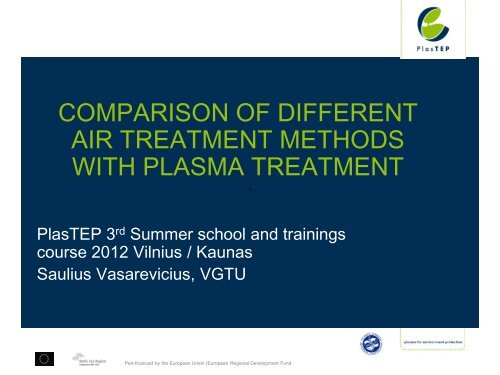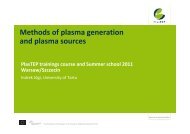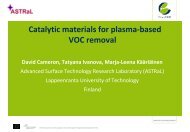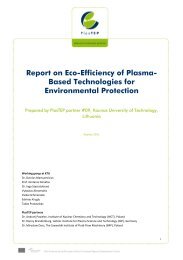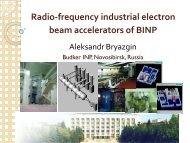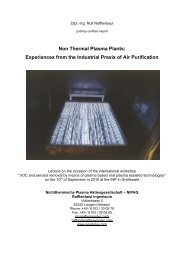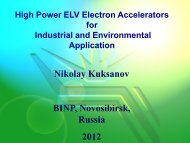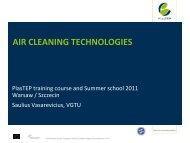Comparison of different air treatment methods with plasma - PlasTEP
Comparison of different air treatment methods with plasma - PlasTEP
Comparison of different air treatment methods with plasma - PlasTEP
You also want an ePaper? Increase the reach of your titles
YUMPU automatically turns print PDFs into web optimized ePapers that Google loves.
COMPARISON OF DIFFERENT<br />
AIR TREATMENT METHODS<br />
WITH PLASMA TREATMENT<br />
<strong>PlasTEP</strong> 3 rd Summer school and trainings<br />
course 2012 Vilnius / Kaunas<br />
Saulius Vasarevicius, VGTU<br />
Part-financed by the European Union (European Regional Development Fund<br />
ˇ
Two Types <strong>of</strong> Air Pollutants<br />
Particulate (Visible)<br />
Gaseous
Stationary Source Control<br />
• Philosophy <strong>of</strong> pollution prevention (3P’s)<br />
– Modify the process: use <strong>different</strong> raw materials<br />
– Modify the process: increase efficiency<br />
– Recover and reuse: less waste = less pollution<br />
• Philosophy <strong>of</strong> end-<strong>of</strong>-pipe <strong>treatment</strong><br />
– Collection <strong>of</strong> waste streams<br />
– Add-on equipment at emission points<br />
• Control <strong>of</strong> stationary sources<br />
– Particulates<br />
– Gases<br />
3
Three Types Of Control<br />
Mechanical<br />
Chemical<br />
Biological
Particulate Control<br />
(Mechanical)<br />
• Electrostatic precipitator<br />
• Bag house fabric filter<br />
• Wet scrubber<br />
• High efficiency cyclones
Particulate Control Technologies<br />
• Remember this order:<br />
– Settling chambers<br />
– Cyclones<br />
– ESPs (electrostatic<br />
precipitators)<br />
– Spray towers<br />
– Venturi scrubbers<br />
– Baghouses (fabric filtration)<br />
• All physical processes
Settling Chambers<br />
• “Knock-out pots”<br />
• Simplest, cheapest, no moving parts<br />
• Least efficient<br />
– large particles only<br />
• Creates solid-waste stream<br />
– Can be reused<br />
• Picture on next slide<br />
8
Disadvantages<br />
• Large space requirement<br />
• Relatively low overall collection<br />
efficiencies (typical 20 - 60 %)<br />
Gravity settler
Flue Gas Cleaning – The state <strong>of</strong> the art<br />
Selection criteria<br />
Emission<br />
mg/Nm 3<br />
ESP Bag house Scrubber Cyclones<br />
(normal)<br />
Spraycone<br />
Cyclones<br />
100 30 200 250 < 100<br />
Reliability ++ + ++ ++++ ++++<br />
Cost ++++ ++++ +++ + +
Gas Cleaning – The state <strong>of</strong> the art<br />
Evaluation <strong>of</strong> ESP for industrial boilers:<br />
• High cost (investment, maintenance & operation)<br />
• Complex large size plant <strong>with</strong> sub-systems<br />
• Requires constant gas conditions (sulphur, temp, moisture)<br />
Evaluation <strong>of</strong> bag filters for industrial boilers:<br />
• High cost (investment, maintenance & filter bags)<br />
• Difficult to handle sulphur and sparks<br />
• Not robust (one faulty bag destroys efficiency<br />
Evaluation <strong>of</strong> wet scrubbers for industrial boilers:<br />
• High cost (large water <strong>treatment</strong> plant)<br />
• Difficult to separate fine particulate<br />
• Sulphur control costly & difficult
Flue Gas Cleaning – The state <strong>of</strong> the art<br />
Evaluation <strong>of</strong> cyclone “grid arrestor” :<br />
• Low collection efficiency due to:<br />
• Wrong design (see velocity analysis)<br />
• Air ingress<br />
• Bad manufacturing quality<br />
• Lack <strong>of</strong> maintenance (blockage <strong>of</strong> cyclone cells)<br />
But cyclone system advantages are low cost and robust installation<br />
Can a cyclone reach efficiencies <strong>of</strong> ESP / Bag filter / Wet scrubber?<br />
This question triggered our cyclone development Program<br />
in 1994 to improve cyclone efficiency and to invent the<br />
“dry spray agglomeration principle”
• Most Common<br />
• Cheapest<br />
Cyclone<br />
• Most Adaptable
Mechanical Collectors –<br />
Cyclones<br />
Advantages: Good for larger PM<br />
Disadvantages: Poor efficiency for finer PM<br />
Difficult removing sticky or wet PM
Cyclone Operating Principle<br />
“Dirty” Air Enters The Side.<br />
The Air Swirls Around The<br />
Cylinder And Velocity Is<br />
Reduced.<br />
Particulate Falls Out Of The Air<br />
To The Bottom Cone And Out.
Flue Gas Cleaning – The state <strong>of</strong> the art<br />
Commercial applications <strong>of</strong> high efficiency cyclones:<br />
BurnerMax<br />
Fluidized bed furnace<br />
High efficiency cyclones<br />
operating at 400 C
Multiple Cyclones<br />
(Multi clone)<br />
Smaller Particles Need Lower<br />
Air Flow Rate To Separate.<br />
Multiple Cyclones Allow<br />
Lower Air Flow Rate, Capture<br />
Particles to 2 microns
Air Filtration
Filtration Mechanisms<br />
• Diffusion<br />
Q: How does efficiency change <strong>with</strong><br />
respect to d p?<br />
a. Efficiency goes up as d p decreases<br />
b. Efficiency goes down as d p decreases
Filtration Mechanisms<br />
• Impaction<br />
Q: How does efficiency change<br />
<strong>with</strong> respect to d p?<br />
a. Efficiency goes up as d p decreases<br />
b. Efficiency goes down as d p decreases
Fat Man’s Misery,<br />
Mammoth Cave NP<br />
Filtration Mechanisms<br />
• Interception
Efficiency<br />
Filter efficiency for individual mechanism<br />
and combined mechanisms<br />
1.0<br />
0.8<br />
0.6<br />
0.4<br />
0.2<br />
Interception<br />
Impaction<br />
Diffusion<br />
Gravitation<br />
Total<br />
0.0<br />
0.01 0.1 1 10<br />
dp (�m)
Fiber filter<br />
FILTRATION<br />
Q: Do filters function just as a strainer,<br />
collecting particles larger than the strainer<br />
spacing?<br />
a: yes<br />
b: no
Filter Drag Model<br />
�� P �<br />
�P<br />
� �Pf<br />
� �Pp<br />
� s<br />
� V K �LVt�V K1 � 2<br />
Areal Dust Density W � LVt<br />
Filter drag<br />
P<br />
S<br />
V<br />
�<br />
� � S � K1<br />
� K2s<br />
W<br />
e<br />
K e & K s to be determined empirically<br />
�P f: fabric pressure drop<br />
�P f: particle layer pressure drop<br />
�P s: structure pressure drop<br />
Q: What is the pressure drop after 100 minutes <strong>of</strong><br />
operation? L = 5 g/m 3 and V = 0.9 m/min.<br />
K e<br />
K s<br />
Time<br />
(min)<br />
�P, Pa<br />
0 150<br />
5 380<br />
10 505<br />
20 610<br />
30 690<br />
60 990
Case A: Pore blocking<br />
Case B: Pore plugging<br />
Case C1: Pore narrowing<br />
Case C2: Pore narrowing w/lost pore<br />
Case D: Pore bridging
• Impaction<br />
• Diffusion<br />
Air Filtration<br />
• Straining (Interception)<br />
• Electrostatics
Fabric Filter<br />
(Baghouse)<br />
• Same Principle As Home<br />
Vacuum Cleaner<br />
• Air Can Be Blown Through Or<br />
Pulled Through<br />
• Bag Material Varies According<br />
To Exhaust Character
Cleaned gas<br />
Dirty gas<br />
Bags<br />
Dust discharge<br />
Baghouse Filter – only one to remove hazardous fine particles
Advantages/Disadvantages<br />
• Very high collection efficiencies<br />
• Pressure drop reasonably low (at beginning <strong>of</strong> operation,<br />
must be cleaned periodically to reduce)<br />
• Can’t handle high T flows or moist environments
Pulse-Air-Jet Type<br />
Baghouse<br />
35
Baghouse
About Baghouses<br />
Efficiency Up To 97+%<br />
(Cyclone Efficiency 70-90%)<br />
Can Capture Smaller Particles<br />
Than A Cyclone<br />
More Complex, Cost More To<br />
Maintain Than Cyclones
Types <strong>of</strong> Baghouses<br />
• The three common types <strong>of</strong> baghouses<br />
based on cleaning <strong>methods</strong><br />
a. Reverse-<strong>air</strong><br />
b. Shaker<br />
c. Pulse-jet
Electrostatic Precipitators<br />
Types include:<br />
• Dry, negatively charged<br />
• Wet-walled, negatively charged<br />
• Two-stage, positively charged
• ELECTROSTATIC PRECIPITATOR<br />
• Advantages <strong>of</strong> Electrostatic Precipitators<br />
� Electrostatic precipitators are capable very high efficiency, generally <strong>of</strong><br />
the order <strong>of</strong> 99.5-99.9%.<br />
� Since the electrostatic precipitators act on the particles and not on the <strong>air</strong>,<br />
they can handle higher loads <strong>with</strong> lower pressure drops.<br />
� They can operate at higher temperatures.<br />
� The operating costs are generally low.<br />
• Disadvantages <strong>of</strong> Electrostatic Precipitators<br />
� The initial capital costs are high.<br />
� Although they can be designed for a variety <strong>of</strong> operating conditions, they<br />
are not very flexible to changes in the operating conditions, once<br />
installed.<br />
� Particulate <strong>with</strong> high resistivity may go uncollected.
http://www.ppcbio.com/ppcdespwhatis.htm
Electrostatic Precipitator Drawing
How An ESP Operates
ESPs<br />
• Electrostatic precipitator<br />
• More expensive to install,<br />
• Electricity is major operating cost<br />
• Higher particulate efficiency than<br />
cyclones<br />
• Can be dry or wet<br />
• Plates cleaned by rapping<br />
• Creates solid-waste stream<br />
• Picture on next slide<br />
44
Electrostatic Precipitator Concept<br />
45
Electrostatic Precipitator<br />
46
Cleaned gas<br />
Dust discharge<br />
Electrodes<br />
Dirty gas<br />
Electrostatic Precipitator – static plates collect particles
Wet Type<br />
• Venturi<br />
• Static packed<br />
• Moving bed<br />
• Tray tower<br />
• Spray towers
Scrubbers<br />
• Gas Contacts A Liquid Stream<br />
• Particles Are Entrained In<br />
The Liquid<br />
• May Also Be A Chemical<br />
Reaction<br />
–Example: Limestone Slurry<br />
With Coal Power Plant Flue Gas
Wet Particle Scrubbers<br />
• Particulate control by impaction,<br />
interception <strong>with</strong> water droplets<br />
• Can clean both gas and particle<br />
phases<br />
• High operating costs, high<br />
corrosion potential
• WET SCRUBBERS (CONTD.)<br />
• Advantages <strong>of</strong> Wet Scrubbers<br />
• Wet Scrubbers can handle incoming streams at high temperature, thus<br />
removing the need for temperature control equipment.<br />
� Wet scrubbers can handle high particle loading.<br />
� Loading fluctuations do not affect the removal efficiency.<br />
� They can handle explosive gases <strong>with</strong> little risk.<br />
� Gas adsorption and dust collection are handled in one unit.<br />
� Corrosive gases and dusts are neutralized.<br />
• Disadvantages <strong>of</strong> Wet Scrubbers<br />
� High potential for corrosive problems<br />
� Effluent scrubbing liquid poses a water pollution problem.
Venturi Scrubber<br />
Detail illustrates cloud atomization from highvelocity<br />
gas stream shearing liquid at<br />
throat<br />
52
Vertical Venturi Scrubber
Packed Bed Scrubber
Dry Scrubber System<br />
http://www.fkinc.com/dirctspraydry.htm#top
Tower Scrubber
Spray Towers<br />
• Water or other liquid “washes out” PM<br />
• Less expensive than ESP but more than<br />
cyclone, still low pressure drop<br />
• Variety <strong>of</strong> configurations<br />
• Higher efficiency than cyclones<br />
• Creates water pollution stream<br />
• Can also absorb some gaseous<br />
pollutants (SO 2)<br />
58
Spray Tower<br />
59
Gaseous Pollutant Control<br />
•Absorption<br />
•Adsorption<br />
•Combustion
Control <strong>of</strong> Air Pollutants<br />
Gaseous pollutants - Combustion<br />
• 3 types <strong>of</strong> combustion systems commonly<br />
utilised for pollution control<br />
– direct flame,<br />
– thermal, and<br />
– catalytic incineration systems
Control <strong>of</strong> Air Pollutants<br />
Gaseous pollutants - Adsorption<br />
• physical adsorption to solid surfaces<br />
• Reversible - adsorbate removed from the<br />
adsorbent by increasing temp. or lowering<br />
pressure<br />
• widely used for solvent recovery in dry<br />
cleaning, metal degreasing operations,<br />
surface coating, and rayon, plastic, and<br />
rubber processing
Control <strong>of</strong> Air Pollutants<br />
Gaseous pollutants - Adsorption<br />
• limited use in solving ambient <strong>air</strong> pollution<br />
problems – <strong>with</strong> its main use involved in the<br />
reduction <strong>of</strong> odour<br />
• Adsorbents <strong>with</strong> large surface area to<br />
volume ratio (activated carbon) preferred<br />
agents for gaseous pollutant control<br />
• Efficiencies to 99%
Carbon Adsorption<br />
• Will do demonstration shortly<br />
• Good for organics (VOCs)<br />
• Both VOCs and carbon can be<br />
recovered when carbon is<br />
regenerated (steam stripping)<br />
• Physical capture<br />
– Adsorption<br />
– Absorption<br />
64
Adsorb<br />
Absorb<br />
66
Control <strong>of</strong> Air Pollutants<br />
Gaseous pollutants - Absorption<br />
• Scrubbers remove gases by chemical<br />
absorption in a medium that may be a liquid<br />
or a liquid-solid slurry<br />
• water is the most commonly used scrubbing<br />
medium<br />
• Additives commonly employed to increase<br />
chemical reactivity and absorption capacity
Pollutants Of Interest<br />
• Volatile Organic Compounds<br />
(VOC)<br />
• Nitrogen Oxides (NOx)<br />
• Sulfur Oxides (SOx)
Controlling Gaseous Pollutants: SO 2 &<br />
NO x<br />
• Modify Process (recall 3P’s)<br />
– Switch to low-sulfur coals<br />
– Desulfurize coal (washing, gasification)<br />
• Increase efficiency<br />
– Low-NO x burners<br />
• Recover and Reuse (heat)<br />
– staged combustion<br />
– flue-gas recirculation<br />
69
Scrubbers / Absorbers<br />
• SO 2 removal: “FGD” (flue gas desulfurization)<br />
– Lime/soda ash/citrate absorbing solutions<br />
– Can create useable by-product OR solid waste<br />
stream<br />
• NO x removal—catalytic and non-catalytic<br />
– Catalyst = facilitates chemical reaction<br />
– Ammonia-absorbing solutions<br />
– Process controls favored over this technology<br />
• CO & CO 2 removal<br />
• Some VOC removal<br />
71
Flue Gas SOx Control<br />
SOx Forms Sulfuric Acid With<br />
Moisture In Air Producing<br />
Acid Rain.<br />
Remove From Flue Gas By<br />
Chemical Reaction With<br />
Limestone
Control Technologies for Nitrogen<br />
• Preventive<br />
– minimizing operating<br />
temperature<br />
– fuel switching<br />
– low excess <strong>air</strong><br />
– flue gas recirculation<br />
– lean combustion<br />
– staged combustion<br />
– low Nox burners<br />
– secondary combustion<br />
– water/steam injection<br />
Oxides<br />
• Post combustion<br />
– selective catalytic reduction<br />
– selective non-catalytic<br />
reduction<br />
– non-selective catalytic<br />
reduction
Thermal Oxidizers<br />
For VOC Control<br />
Also Called Afterburners
Thermal Oxidation<br />
• Chemical change = burn<br />
– CO 2 and H 2O ideal end products <strong>of</strong> all processes<br />
• Flares (for emergency purposes)<br />
• Incinerators<br />
– Direct<br />
– Catalytic = improve reaction efficiency<br />
– Recuperative: heat transfer between inlet /exit gas<br />
– Regenerative: switching ceramic beds that hold<br />
heat, release in <strong>air</strong> stream later to re-use heat<br />
75
• Catalytic<br />
Two Types Of Oxidizer<br />
• Non-Catalytic
Thermal Oxidizer<br />
(Non-Catalytic)
Catalytic Thermal Oxidizer
Biological Method<br />
• Uses Naturally Occurring<br />
Bacteria (Bugs) To Break<br />
Down VOC<br />
• “Bugs” Grow On Moist Media<br />
And Dirty Gas Is Passed<br />
Through. Bugs Digest The<br />
VOC.<br />
• Result Is CO2 And H2O
A Bio Filter For VOC Removal
Other Technologies<br />
• High-temp ceramic filter<br />
• Operates at T > 500 F (limit for<br />
baghouses)
E-beam flue gas <strong>treatment</strong> process<br />
(Pr<strong>of</strong>. A.Chmielewski)
Pollutants removed by EB method<br />
The method has been designed for simultaneous removal <strong>of</strong>:<br />
• SO2<br />
• NOx<br />
• Cl, HF etc.<br />
• Volatile Organic Hydrocarbons (VOC)<br />
• Dioxins<br />
• Mercury<br />
• Others…
Electron beam effect on gas, primary radiolysis products:<br />
• 4.43N2 -› 0.29N2* + 0.885N(2D) + 0.295N(2P) + 1.87N(4S) + 2.27N2+ +<br />
0.69N+ + 2.96e-<br />
• 5.377O2 -› 0.077O2* + 2.25O(1D) + 2.8O(3P) + 0.18O* + 2.07O2+ +<br />
1.23O+ + 3.3e-<br />
• 7.33H2O -› 0.51H2 + 0.46O(3P) + 4.25OH + 4.15H +1.99 H2O+ + 0.01H2+<br />
+ 0.57OH+ + 0.67H+ + 0.06O+ + 3.3e-<br />
• 7.54CO2 -› 4.72CO + 5.16O(3P) + 2.24CO2+ + 0.51CO+ + 0.07C+ +<br />
0.21O+ + 3.03 e-
Electron beam effect on gas, secondary reactions:<br />
• O(1D) + H2O͢͢͢͢ ͢͢͢͢͢͢͢͢͢͢͢͢<br />
-› 2OH*<br />
• N2+ + 2H2O -› H3O+ + OH*+ N2<br />
• O(3P) + O2+ M -› O3+ M<br />
• e-+ O2 + M -› O2-+ M<br />
• H3O+ + O2- -› HO2*+ H2O<br />
As a result <strong>of</strong> these primary and secondary reactions OH*,<br />
HO2 *, O*radicals, O3and other oxidizing species are<br />
formed, that can oxidize NO, SO2 and Hg.
Radiothermal:<br />
SO2 removal pathways<br />
• SO2 + OH* + M -› HSO3 + M<br />
• HSO3 + O2 -› SO3 + HO2*<br />
• SO3 + H2O -› H2SO4<br />
• H2SO4 + 2NH3 -› (NH4)2SO4<br />
Thermal:<br />
• SO2 + 2NH3 -› (NH3)2SO2<br />
• (NH3)2SO2 -› (NH4)2SO4
NO oxidation<br />
NOx removal pathways<br />
• NO + O(3P) + M -› NO2+ M<br />
• O(3P) + O2+ M -› O3+ M<br />
• NO + O3+ M -› NO2+ O2+ M<br />
• NO + HO2* + M -› NO2+ OH* +M<br />
• NO + OH* + M -› HNO2+M<br />
• HNO2+ OH* -› NO2+ H2O<br />
NO2removal<br />
• NO2+ OH* + M -›HNO3+ M<br />
• HNO3+ NH3-›NH4NO3
Reaction mechanisms and sequence<strong>of</strong> E-beam process<br />
H. Namba: Materials <strong>of</strong> UNDP(IAEA)RCA Regional Training Course on<br />
Radiation Technology for Environmental Conservation TRCE-JAERI,<br />
Takasaki,
VOC-decomposition and deodorization <strong>methods</strong><br />
Thermal Processes: 1-TO, Thermal Oxidation; 2-RTO, Regenerative Thermal Oxidation; 3-<br />
Catalytic Oxidation <strong>with</strong> Recuperation. Filtering/Adsorption: 4-Bi<strong>of</strong>ilters; 5-Scrubber; 7-<br />
Adsorption Container; 8-Concentrator Unit <strong>with</strong> TO; 9-Filtering. Non-thermal Oxidation: 6a-<br />
Electrical Non-thermal oxidation; 6b-UVS Non-thermal Oxidation.
Non-thermal <strong>plasma</strong>s:<br />
VOC-decomposition<br />
• Decomposition <strong>of</strong> contaminants <strong>with</strong>out heating<br />
• Wide range <strong>of</strong> pollutants (Gases ... Particulate Matter PM)<br />
• Decomposition <strong>of</strong> organic PM<br />
• High efficiency for low contamination (e.g. deodorization), ([VOCs] < 1 g<br />
Corg/m3)<br />
Negative aspects:<br />
• High energy cost/molecule_ high energy for high concentrations<br />
• Uncompleted conversion and by-products _ low selectivity (CO2)<br />
• Deposition <strong>of</strong> polymer films in reactors _ unstable <strong>plasma</strong> source<br />
Possibilities - indirect <strong>treatment</strong>, hybrid <strong>methods</strong> = combination <strong>of</strong> <strong>plasma</strong> <strong>with</strong>:<br />
catalysts, scrubbing, adsorbents…
VOC decomposition by O2 <strong>plasma</strong>
Aromatic VOC decomposition mechanism. Positive ions’<br />
charget transfer reactions<br />
• M++ RH = M + RH+<br />
• Radical –neutral particles reactions<br />
• OH radical reactions<br />
• ˙OH + C6H5CH3= R1˙(OH radical addition)<br />
• C6H5CH3+ ˙OH = R2˙ + H2O ( H atom abstraction)<br />
• C6H6+ ˙OH = C6H5OH + H (H atom elimination)<br />
• Organic radicals’ reactions<br />
• R˙ + O2= RO2˙<br />
• 2 RO2˙ = 2RO˙ + O2<br />
• RO2˙ + NO = RO˙ + NO2<br />
• RO˙ + O2= HO2˙ + products ( aromatic-CHO, -OH)<br />
• RO˙ -› aliphatic products<br />
R. Atkinson: Chem. Rev. 85(1985) 69
Non thermal <strong>plasma</strong>
PDC for deodorization (commercial)
CML 2001, Experts IKP (Central Europe)<br />
1200<br />
1000<br />
800<br />
600<br />
400<br />
200<br />
0<br />
By-products<br />
Material resources<br />
Electricity<br />
74.4<br />
1099.7<br />
EBFGT WFGD + SCR<br />
Total weighed environmental impact <strong>of</strong> <strong>plasma</strong> and non-<strong>plasma</strong> end-<strong>of</strong>-pipe<br />
pollutant <strong>treatment</strong> technologies: the comparison <strong>of</strong> technologies for SOx/NOx<br />
removal. 1) Electron Beam Flue Gas Treatment (EBFGT) versus 2) Wet Flue Gas<br />
Desulphurization <strong>with</strong> Selective Catalytic Reduction (WFGD+SCR
CML 2001, Experts IKP (Central Europe)<br />
50<br />
40<br />
30<br />
20<br />
10<br />
0<br />
By-products<br />
Material resources<br />
Electricity<br />
4.2<br />
Total weighed environmental impact <strong>of</strong> <strong>plasma</strong> and non-<strong>plasma</strong> end-<strong>of</strong>-pipe<br />
pollutant <strong>treatment</strong> technologies: the comparison <strong>of</strong> technologies for VOCs<br />
removal. 1) Dielectric barrier discharge (DBD) versus 2) adsorption by zeolite (for<br />
LCA) and molecular sieves (for CBA), 3) bi<strong>of</strong>iltration,<br />
41.1<br />
DBD <strong>plasma</strong> Adsorption<br />
(zeolite rotor)<br />
26.1<br />
Bi<strong>of</strong>ilttration
Flue gas <strong>treatment</strong> method >300<br />
MW unit<br />
Investment costs<br />
€/kW<br />
Annual operation costs<br />
€/MW<br />
EBFGT 32-45 1290-1577<br />
Wet deSO2 + SCR 176-247 4786-5350<br />
Wet deSO2 + SNCR 144-190 3870-4223<br />
Emission control method 120 MW<br />
unit<br />
Investment costs<br />
€/kW<br />
Annual operation costs<br />
€/MW<br />
EBFGT 113 5167<br />
WFGT+SCR 162 5343<br />
Investment and operation costs <strong>of</strong> EBFGT and combination <strong>of</strong> conventional deSO 2 and deNOx<br />
Full “Report on Eco-Efficiency <strong>of</strong> Plasma-Based technologies for Environmental Protection” and<br />
“Report on cost-benefit analysis <strong>of</strong> <strong>plasma</strong>-based technologies“ are available at the <strong>PlasTEP</strong><br />
project website (http://www.plastep.eu/fileadmin/dateien/Outputs/OP3-2.1_Ecoefficiency_report.pdf,<br />
http://www.plastep.eu/fileadmin/datein/Outputs/120208_CBA.pdf).
Thank You for Your attention!


